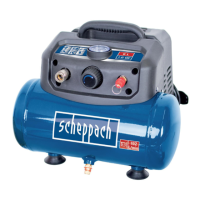www.scheppach.com
30
|
GB
13. Troubleshooting
Fault Possible cause Remedy
The compressor
does not start.
Mains voltage is not available. Check the cable, mains plug, fuse and socket.
Mains voltage is too low.
Make sure that the extension cable is not too long.
Use an extension cable with large enough wires.
Outside temperature is too low.
Never operate with an outside temperature of below
+5° C.
Motor is overheated.
Allow the motor to cool down. If necessary, remedy
the cause of the overheating.
The compressor
starts but there is
no pressure.
Non-return valve leaking Replace the non-return valve.
The seals are damaged.
Check the seals and have any damaged seals re-
placed by a service centre.
Drain screw for condensate (9)
leaking.
Tighten the screw by hand.
Check the seal on the screw and replace if necessary.
The compressor
starts, pressure is
shown on the pres-
sure gauge, but the
tools do not start.
The hose connections have a leak.
Check the compressed air hose and tools and replace
if necessary.
A quick coupling has a leak. Check quick coupling, replace if necessary.
Pressure set too low at pressure
regulator (3).
Increase the set pressure with the pressure regulator.
- Points of sale of electrical appliances (stationary
and online) provided traders are obliged to take
them back or oer this voluntarily.
- Up to three waste electrical devices per type of
device, with an edge length of no more than 25
centimetres, can be returned free of charge to
the manufacturer without prior purchase of a new
device from the manufacturer or taken to another
authorised collection point in your vicinity.
- Further supplementary take-back conditions of
the manufacturers and distributors can be ob-
tained from the respective customer service.
• If the manufacturer delivers a new electrical appli-
ance to a private household, the manufacturer can
arrange for the free collection of the old electrical
appliance upon request from the end user. Please
contact the manufacturer’s customer service for
this.
• These statements only apply to appliances that
are installed and sold in the countries of the Euro-
pean Union and are subject to European Directive
2012/19/EU. Dierent provisions may apply to the
disposal of electrical and electronic appliances in
countries outside the European Union.
Information on the German Electrical and Elec-
tronic Equipment Act (ElectroG)
Electrical and electronic appliances do not
belong in household waste, but should be
collected and disposed of separately.
• Used batteries or rechargeable batteries that are not
installed permanently in the old appliance must be
removed non-destructively before disposal. Their
disposal is regulated by the battery law.
• Owners or users of electrical and electronic appli-
ances are obliged by law to return them after use.
• The end user bears personal responsibility for de-
leting his personal data from the old appliance to be
disposed of.
• The symbol of the crossed-through rubbish bin
means that electrical and electronic appliances may
not be disposed of in the household rubbish.
• Electrical and electronic appliances can be handed
in at the following places at no charge:
- Public service disposal or collection points (e.g.
municipal building yards)

